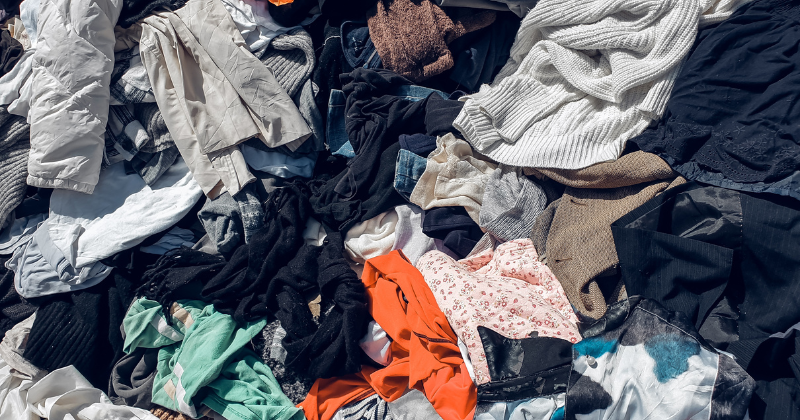Introduction
The fashion and textile industry are subject to various environmental, social and governance (ESG) considerations. In recognition of this year’s International Day of Zero Waste, we highlight the environmental challenges posed by fast fashion.
With each season, new fashion trends emerge in stores worldwide, enticing consumers eager to purchase the latest designs as fresh collections and sales become available. This growing demand drives manufacturers to accelerate production, particularly in the age of social media, where news of emerging trends spreads rapidly among users.
While this cycle fuels economic growth, it also exacerbates textile waste, one of the fashion industry’s most pressing environmental concerns. The rapid turnover of clothing – often referred to as “fast fashion” – results in massive amounts of discarded textiles, overwhelming landfills and polluting ecosystems.
Recognising the urgency of addressing textile waste, the United Nations General Assembly at its seventy seventh session held on 14th December 2022 adopted resolution 77/161 titled ‘Promoting zero-waste initiatives to advance the 2030 Agenda for Sustainable Development’ which proclaimed 30th March as the International Day of Zero Waste.
This year’s Zero Waste Day focuses on the fashion and textile industry, a sector notorious for its environmental footprint. The initiative highlights scalable solutions that promote circular economies, responsible production and waste reduction.
Like many other nations, Kenya grapples with the environmental and economic consequences related to textile waste. This article examines Kenya’s efforts towards sustainability in the fashion and textile industry.
The Legal and Regulatory Framework governing Kenya’s Fashion and Textile Industry
Kenya has implemented various laws and policies to promote sustainable practices in the textile industry. Additionally, the Ministry of Investments, Trade and Industry oversees the regulation and development of Kenya’s fashion and textile industry, with its key functions including the promotion of industrial growth and enforcement of trade policies.
Kenya’s regulatory framework aims to protect the environment while fostering economic growth in the sector. Some of these laws and policies include:
(a) The Constitution of Kenya, 2010
While the Constitution does not directly regulate the fashion and textile industry, it lays the foundation for sustainability and environmental protection through its provisions. For instance, Article 42 guarantees every person the right to a clean and healthy environment which directly applies to the textile industry by addressing pollution and waste management. Additionally, Article 69(1) mandates the State to ensure sustainable exploitation, utilization, management and conservation of the environment, which includes regulating textile waste and enforcing sustainable practices in textile sourcing, processing and subsequent distribution.
Article 69(2) also obliges every person to cooperate with State organs and other stakeholders to protect and conserve the environment and ensure ecologically sustainable development, reinforcing the need for ethical fashion practices and responsible consumption.
(b) Environmental Management and Co-ordination Act (Chapter 387, Laws of Kenya) (the “EMCA”)
The EMCA was enacted to establish an appropriate legal and institutional framework for the management of the environment and has paved the way for the necessary legal and administrative co-ordination of intersectoral initiatives that are geared at appropriate environmental management. Furthermore, it is guided by principles that ensure that every person is entitled to a clean and healthy environment.
Additionally, the EMCA outlines pollution prevention, waste management, and the protection of natural resources, including biodiversity conservation. It also mandates sustainable development practices and encourages public awareness and local community involvement in environmental decision-making.
Furthermore, the EMCA establishes the National Environmental Management Authority (“NEMA”), under section 7(1), whose primary responsibility is to oversee and coordinate all matters relating to the environment and implement all polices developed with respect to the environment.
Finally, it has also provided for the various enforcement mechanisms, including penalties for non-compliance, and ensures liability for environmental damage.
Overall, the EMCA ensures that waste, including textile waste, is managed responsibly, with an emphasis on minimising harm, promoting recycling and ensuring the sustainability of natural resources.
(c) Sustainable Waste Management Act (Chapter 387C, Laws of Kenya) (the “Act”)
The Act establishes the legal and institutional framework for sustainable waste management, ensuring the realization of the right to a clean and healthy environment.
Pursuant to section 2, the Act defines waste as any substance, material or object intended for disposal, whether or not it can be reused, recycled or recovered. This includes industrial waste, which is particularly relevant to the fashion and textile industry due to the significant waste generated in textile production, distribution and disposal.
Among the objectives of the Act under section 3 is to promote sustainable waste management, which involves efficient resource use to minimize waste generation and maximize recovery, recycling and reuse.
Additionally, section 4 outlines the general principles underlying the Act such as the zero waste principle. According to the Act, this principle mandates that products and processes be designed to: reduce the volume and toxicity of waste and materials; conserve and recover all resources; prevent landfilling and incineration, instead treat waste as a resource that can be harnessed for wealth creation, employment and reduction of pollution.
(d) The Sustainable Waste Management (Extended Producer Responsibility) Regulations, 2024 and the Sustainable Waste Management (Extended Producer Responsibility) (Amendment) Regulations, 2025 (the “EPR Regulations”)
These regulations came into force on 4th November 2024, pursuant to section 13(3) of the Act, which oblige the Cabinet Secretary for Environment, Climate Change and Forestry to make regulations on extended producer responsibility (“EPR”).
Under section 2 of the Act, EPR is defined as an environmental management approach in which a producer’s responsibility extends beyond manufacturing to the post-consumer stage of a product’s life cycle.
A producer is also defined as an entity that introduces goods, products and packaging into Kenya using authorized means by manufacturing, importing, converting, repackaging or rebranding.
The EPR Regulations are particularly significant for the fashion and textile industry, which faces challenges related to the dumping of second-hand clothes – popularly known as ‘mitumba’ from developed countries. Many of these discarded textiles are often of low quality and end up as waste, burdening Kenya’s waste management systems.
Regulation 3 outlines the object and purpose of the regulations, which include operationalizing the polluter pays principle – ensuring that producers bear the financial and operational responsibility for managing waste associated with their products.
The EPR Regulations apply to producers, EPR compliance schemes and products such as textiles, that negatively impact on the environment, human and animal health due to challenges in reuse, recyclability and recoverability as well as high management costs and associated risks.
Some of the EPR obligations placed upon producers by regulation 5(1) include: registration with NEMA and designing products and packaging materials that minimize waste and are environmentally friendly at the end of their life.
Under Regulation 6, importers of finished products listed in the First Schedule, such as textiles, are required to pay the prescribed fees to NEMA at the point of importation. For instance, the prescribed fee for textiles is KES. 150 per item. Additionally, importers are required to apply for an EPR certificate from NEMA at the time of import. This certificate is a mandatory requirement for clearance and inspection of any products covered under the First Schedule.
The Hidden Costs of Textile Waste
Textile waste in Kenya imposes significant but often overlooked economic, environmental and social burdens. The high volumes of discarded textiles overwhelm waste management systems, leading to increased disposal costs. Additionally, the dominance of second-hand clothing has weakened local textile production, resulting in job losses and missed opportunities in recycling and upcycling industries.
From an environmental perspective, textile waste contributes to air, land and water pollution. The manufacturing process emits harmful pollutants at various stages from fibre production and dyeing to transportation and disposal. Synthetic fibres release greenhouse gases when processed, while chemical treatments introduce toxic substances into the air and water. Additionally, the burning of textile waste – a common practice due to poor waste management – worsens air quality and poses health risks to communities.
Socially, informal waste handling exposes vulnerable groups to hazardous working conditions and exploitation. Many individuals, particularly in low-income areas, rely on sorting and reselling textile waste under unsafe and unregulated conditions, leading to long-term health complications, with synthetic fibres and chemicals contaminating soil, rivers and groundwater.
Conclusion
The fashion and textile industry play a vital role in Kenya’s economy, but its environmental and social costs cannot be ignored. The rapid rise of fast fashion and second-hand clothing imports has led to a surge in textile waste, straining waste management systems, polluting the environment and undermining local textile production. The hidden costs of textile waste – from air, water and land pollution to economic losses and health risks – underscore the urgent need for sustainable solutions.
Kenya has made strides in addressing these challenges through legal and policy frameworks including the Sustainable Waste Management Act and the EPR Regulations. These regulations aim to promote responsible production, encourage recycling or upcycling and hold producers accountable for waste management. However, the success of this framework will depend on effective enforcement, industry compliance and public awareness.
At the same time, the global shift towards sustainable fashion presents an opportunity for Kenya and other developing nations. Governments, businesses and consumers are increasingly adopting circular economy models, ethical production and responsible consumption. Initiatives such as the European Union’s Strategy for Sustainable and Circular Textiles 2022 which seek to make textiles more durable, recyclable and free from hazardous substances and stricter regulations in developed markets are shaping the global textile trade. Kenya’s waste management policies align with this trend, but greater enforcement, investment and innovation will be key to ensuring that sustainability becomes the standard rather than the exception.
Download the Alert here.





